Utilizing Machine Learning to Examine the Spatiotemporal Changes in Africa’s Partial Atmospheric Layer Thickness
Abstract
:1. Introduction
2. Data and Methods
2.1. Data
2.2. Methods
3. Results
3.1. Trend Analysis of the Atmospheric Layer Thickness
3.2. Seasonal Spatial Decomposition of the Atmospheric Layer Thickness
3.3. Application of Deep Learning in Assessing Regional Thickness Changes
4. Discussion
5. Conclusions
Supplementary Materials
Author Contributions
Funding
Institutional Review Board Statement
Informed Consent Statement
Data Availability Statement
Conflicts of Interest
References
- Sylla, M.B.; Nikiema, P.M.; Gibba, P.; Kebe, I.; Klutse, N.A.B. Climate Change over West Africa: Recent Trends and Future Projections. Adapt. Clim. Chang. Var. Rural. West Afr. 2016, 25–40. [Google Scholar] [CrossRef]
- Nicholson, S.E. Climate of the Sahel and West Africa. Oxford Res. Encycl. Clim. Sci. 2018. [Google Scholar] [CrossRef]
- Kruger, A.C.; Shongwe, S. Temperature trends in South Africa: 1960–2003. Int. J. Clim. 2004, 24, 1929–1945. [Google Scholar] [CrossRef]
- MacKellar, N.; New, M.; Jack, C. Observed and modelled trends in rainfall and temperature for South Africa: 1960–2010. S. Afr. J. Sci. 2014, 110, 1–13. [Google Scholar] [CrossRef]
- Ceccherini, G.; Russo, S.; Ameztoy, I.; Francesco Marchese, A.; Carmona-Moreno, C. Heat waves in Africa 1981–2015, observations and reanalysis. Nat. Hazards Earth Syst. Sci. 2017, 17, 115–125. [Google Scholar] [CrossRef]
- Ibebuchi, C.; Lee, C. Global trends in atmospheric layer thickness since 1940 and relationships with tropical and extratropical climate forcing. Environ. Res. Lett. 2023, 18, 104007. [Google Scholar] [CrossRef]
- Kelley, O.A. Where the Least Rainfall Occurs in the Sahara Desert, the TRMM Radar Reveals a Different Pattern of Rainfall Each Season. J. Clim. 2014, 27, 6919–6939. [Google Scholar] [CrossRef]
- Dyer, E.L.E.; Jones, D.B.A.; Li, R.; Sawaoka, H.; Mudryk, L. Sahel precipitation and regional teleconnections with the Indian Ocean. J. Geophys. Res. Atmos. 2017, 122, 5654–5676. [Google Scholar] [CrossRef]
- Russo, S.E.; Kitajima, K. The Ecophysiology of Leaf Lifespan in Tropical Forests: Adaptive and Plastic Responses to Environmental Heterogeneity. Trop. Tree Physiol. Adapt. Responses A Change Environ. 2016, 357–383. [Google Scholar] [CrossRef]
- Dosio, A.; Fischer, E.M. Will Half a Degree Make a Difference? Robust Projections of Indices of Mean and Extreme Climate in Europe Under 1.5 °C, 2 °C, and 3 °C Global Warming. Geophys. Res. Lett. 2018, 45, 935–944. [Google Scholar] [CrossRef]
- Ayugi, B.; Shilenje, Z.W.; Babaousmail, H.; Lim Kam Sian, K.T.C.; Mumo, R.; Dike, V.N.; Iyakaremye, V.; Chehbouni, A.; Ongoma, V. Projected changes in meteorological drought over East Africa inferred from bias-adjusted CMIP6 models. Nat. Hazards 2022, 113, 1151–1176. [Google Scholar] [CrossRef] [PubMed]
- Ghansah, B.; Nyamekye, C.; Owusu, S.; Agyapong, E. Mapping flood prone and Hazards Areas in rural landscape using landsat images and random forest classification: Case study of Nasia watershed in Ghana. Cogent Eng. 2021, 8, 1923384. [Google Scholar] [CrossRef]
- Engelbrecht, F.; Adegoke, J.; Bopape, M.-J.; Naidoo, M.; Garland, R.; Thatcher, M.; McGregor, J.; Katzfey, J.; Werner, M.; Ichoku, C.; et al. Projections of rapidly rising surface temperatures over Africa under low mitigation. Environ. Res. Lett. 2015, 10, 085004. [Google Scholar] [CrossRef]
- Dosio, A. Projection of temperature and heat waves for Africa with an ensemble of CORDEX Regional Climate Models. Clim. Dyn. 2017, 49, 493–519. [Google Scholar] [CrossRef]
- James, R.; Washington, R. Changes in African temperature and precipitation associated with degrees of global warming. Clim. Change 2013, 117, 859–872. [Google Scholar] [CrossRef]
- White, D.; Richman, M.; Yarnal, B. Climate regionalization and rotation of principal components. Int. J. Clim. 1991, 11, 1–25. [Google Scholar] [CrossRef]
- Cheng, S.; Prentice, I.C.; Huang, Y.; Jin, Y.; Guo, Y.-K.; Arcucci, R. Data-driven surrogate model with latent data assimilation: Application to wildfire forecasting. J. Comput. Phys. 2022, 464, 111302. [Google Scholar] [CrossRef]
- Tibau, X.A.; Reimers, C.; Requena-Mesa, C.; Runge, J. Spatio-Temporal Autoencoders in Weather and Climate Research. Deep. Learn. Earth Sci. A Compr. Approach Remote Sens. Clim. Sci. Geosci. 2021, 186–203. [Google Scholar] [CrossRef]
- Rautela, K.S.; Singh, S.; Goyal, M.K. Characterizing the spatio-temporal distribution, detection, and prediction of aerosol atmospheric rivers on a global scale. J. Environ. Manag. 2024, 351, 119675. [Google Scholar] [CrossRef]
- Meghani, S.; Singh, S.; Kumar, N.; Goyal, M.K. Predicting the spatiotemporal characteristics of atmospheric rivers: A novel data-driven approach. Glob. Planet. Chang. 2023, 231, 104295. [Google Scholar] [CrossRef]
- Donnelly, J.; Daneshkhah, A.; Abolfathi, S. Forecasting global climate drivers using Gaussian processes and convolutional autoencoders. Eng. Appl. Artif. Intell. 2024, 128, 107536. [Google Scholar] [CrossRef]
- Hersbach, H.; Bell, B.; Berrisford, P.; Hirahara, S.; Horányi, A.; Muñoz-Sabater, J.; Nicolas, J.; Peubey, C.; Radu, R.; Schepers, D.; et al. The ERA5 global reanalysis. Q. J. R. Meteorol. Soc. 2020, 146, 1999–2049. [Google Scholar] [CrossRef]
- Kalnay, E.; Kanamitsu, M.; Kistler, R.; Collins, W.; Deaven, D.; Gandin, L.; Iredell, M.; Saha, S.; White, G.; Woollen, J.; et al. The NCEP/NCAR 40-Year Reanalysis Project. Bull. Am. Meteorol. Soc. 1996, 77, 437–471. [Google Scholar] [CrossRef]
- Mocsari, E.; Stone, S.S. Colostral IgA, IgG, and IgM-IgA Fractions as Fluorescent Antibody for the Detection of the Coronavirus of Transmissible Gastroenteritis. Am. J. Vet. Res. 1978, 39, 1442–1446. [Google Scholar] [PubMed]
- Yue, S.; Wang, C.Y. The Mann-Kendall Test Modified by Effective Sample Size to Detect Trend in Serially Correlated Hydrological Series. Water Resour. Manag. 2004, 18, 201–218. [Google Scholar] [CrossRef]
- Benjamini, Y. Discovering the False Discovery Rate. J. R. Stat. Soc. Ser. B Stat. Methodol. 2010, 72, 405–416. [Google Scholar] [CrossRef]
- Ibebuchi, C.C.; Abu, I.-O. Rainfall variability patterns in Nigeria during the rainy season. Sci. Rep. 2023, 13, 7888. [Google Scholar] [CrossRef] [PubMed]
- Ibebuchi, C.; Richman, M.; Chiedozie Ibebuchi, C.; Richman, M.B. Circulation typing with fuzzy rotated T-mode principal component analysis: Methodological considerations. Theor. Appl. Clim. 2023, 153, 495–523. [Google Scholar] [CrossRef]
- R Core Team. R: A Language and Environment for Statistical Computing; R Foundation for Statistical Computing: Vienna, Austria, 2022. [Google Scholar]
- Hinton, G.E.; Salakhutdinov, R.R. Reducing the Dimensionality of Data with Neural Networks. Science 2006, 313, 504–507. [Google Scholar] [CrossRef]
- Zhou, C.; Paffenroth, R.C. Anomaly Detection with Robust Deep Autoencoders. In Proceedings of the 23rd ACM SIGKDD International Conference on Knowledge Discovery and Data Mining, Halifax, NS, Canada, 13–17 August 2017; Part F129685. pp. 665–674. [Google Scholar]
- Chen, Z.; Yeo, C.K.; Lee, B.S.; Lau, C.T. Autoencoder-Based Network Anomaly Detection. In Proceedings of the 2018 Wireless Telecommunications Symposium (WTS), Phoenix, AZ, USA, 17–20 April 2018. [Google Scholar] [CrossRef]
- Homayouni, H.; Ghosh, S.; Ray, I.; Gondalia, S.; Duggan, J.; Kahn, M.G. An Autocorrelation-Based LSTM-Autoencoder for Anomaly Detection on Time-Series Data. In Proceedings of the 2020 IEEE International Conference on Big Data (Big Data), Atlanta, GA, USA, 10–13 December 2020; pp. 5068–5077. [Google Scholar] [CrossRef]
- Mendes, T.; Cardoso, P.J.S.; Monteiro, J.; Raposo, J. Anomaly Detection of Consumption in Hotel Units: A Case Study Comparing Isolation Forest and Variational Autoencoder Algorithms. Appl. Sci. 2022, 13, 314. [Google Scholar] [CrossRef]
- Edelmann, D.; Móri, T.F.; Székely, G.J. On relationships between the Pearson and the distance correlation coefficients. Stat. Probab. Lett. 2021, 169, 108960. [Google Scholar] [CrossRef]
- Goodfellow, I. NIPS 2016 Tutorial: Generative Adversarial Networks. arXiv 2016, arXiv:1701.00160. [Google Scholar]
- Kingma, D.P.; Rezende, D.J.; Mohamed, S.; Welling, M. Semi-Supervised Learning with Deep Generative Models. Adv. Neural Inf. Process. Syst. 2014, 4, 3581–3589. [Google Scholar]
- Hurrell, J.W.; Kushnir, Y.; Ottersen, G.; Visbeck, M. An overview of the North Atlantic Oscillation. Geophys. Monogr. Ser. 2003, 134, 1–35. [Google Scholar] [CrossRef]
- Wang, J.; Ikeda, M. Arctic oscillation and Arctic sea-ice oscillation. Geophys. Res. Lett. 2000, 27, 1287–1290. [Google Scholar] [CrossRef]
- Wilkie, D.; Morelli, G.; Rotberg, F.; Shaw, E. Wetter isn’t better: Global warming and food security in the Congo Basin. Glob. Environ. Change 1999, 9, 323–328. [Google Scholar] [CrossRef]
- Haensler, A.; Saeed, F.; Jacob, D. Assessing the robustness of projected precipitation changes over central Africa on the basis of a multitude of global and regional climate projections. Clim. Chang. 2013, 121, 349–363. [Google Scholar] [CrossRef]
- Samba, G.; Nganga, D. Minimum and Maximum Temperature Trends in Congo-Brazzaville: 1932–2010. Atmos. Clim. Sci. 2014, 4, 404–430. [Google Scholar] [CrossRef]
- Creese, A.; Washington, R.; Jones, R. Climate change in the Congo Basin: Processes related to wetting in the December–February dry season. Clim. Dyn. 2019, 53, 3583–3602. [Google Scholar] [CrossRef]
- Zakari, S.; Ibro, G.; Moussa, B.; Abdoulaye, T. Adaptation Strategies to Climate Change and Impacts on Household Income and Food Security: Evidence from Sahelian Region of Niger. Sustainability 2022, 14, 2847. [Google Scholar] [CrossRef]
- Tian, C.; Huang, G.; Lu, C.; Song, T.; Wu, Y.; Duan, R. Northward Shifts of the Sahara Desert in Response to Twenty-First-Century Climate Change. J. Clim. 2023, 36, 3417–3435. [Google Scholar] [CrossRef]
- Zhou, L.; Hua, W.; Nicholson, S.E.; Clark, J.P. Interannual teleconnections in the Sahara temperatures associated with the North Atlantic Oscillation (NAO) during boreal winter. Clim. Dyn. 2023, 1–21. [Google Scholar] [CrossRef]

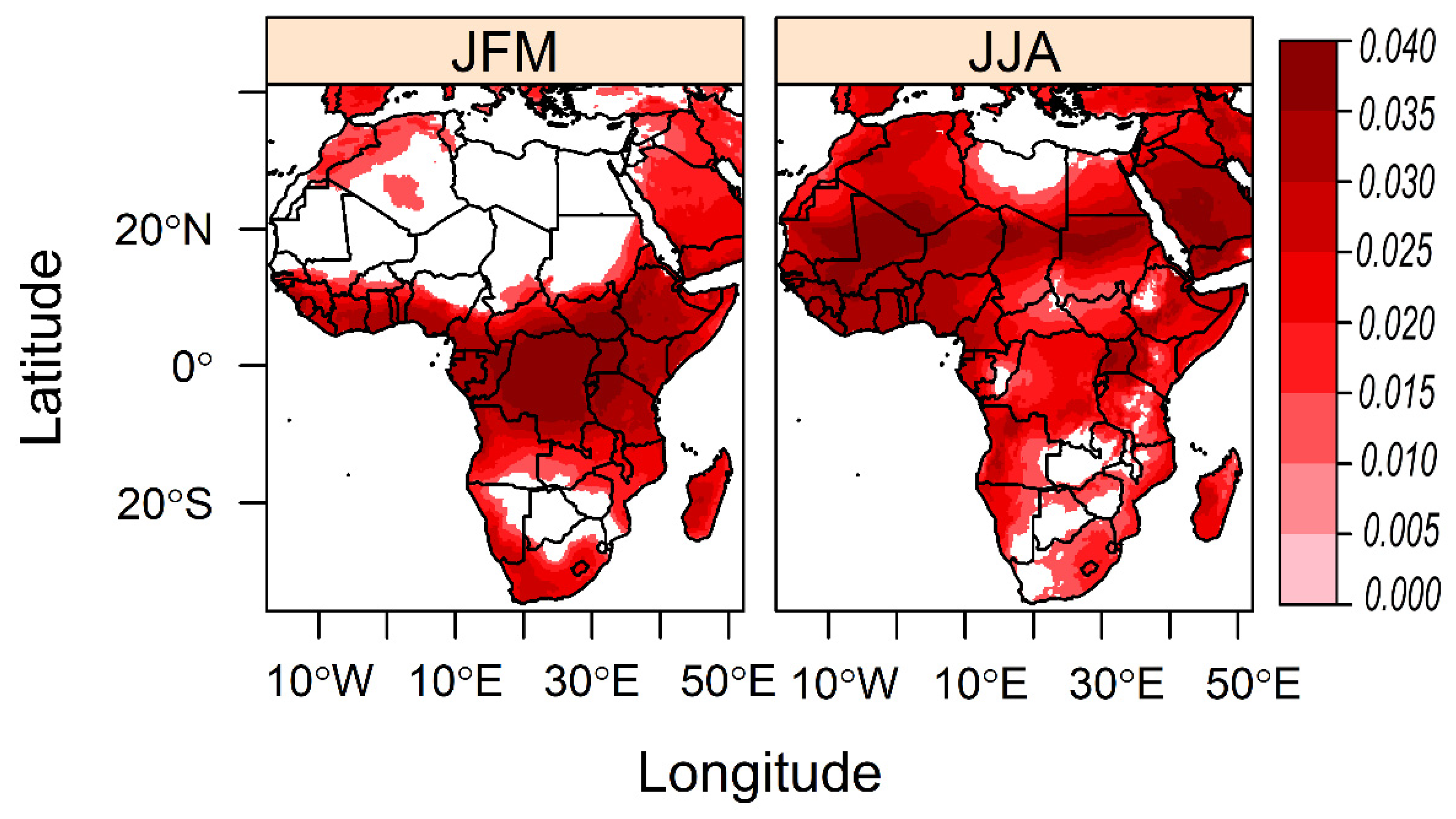


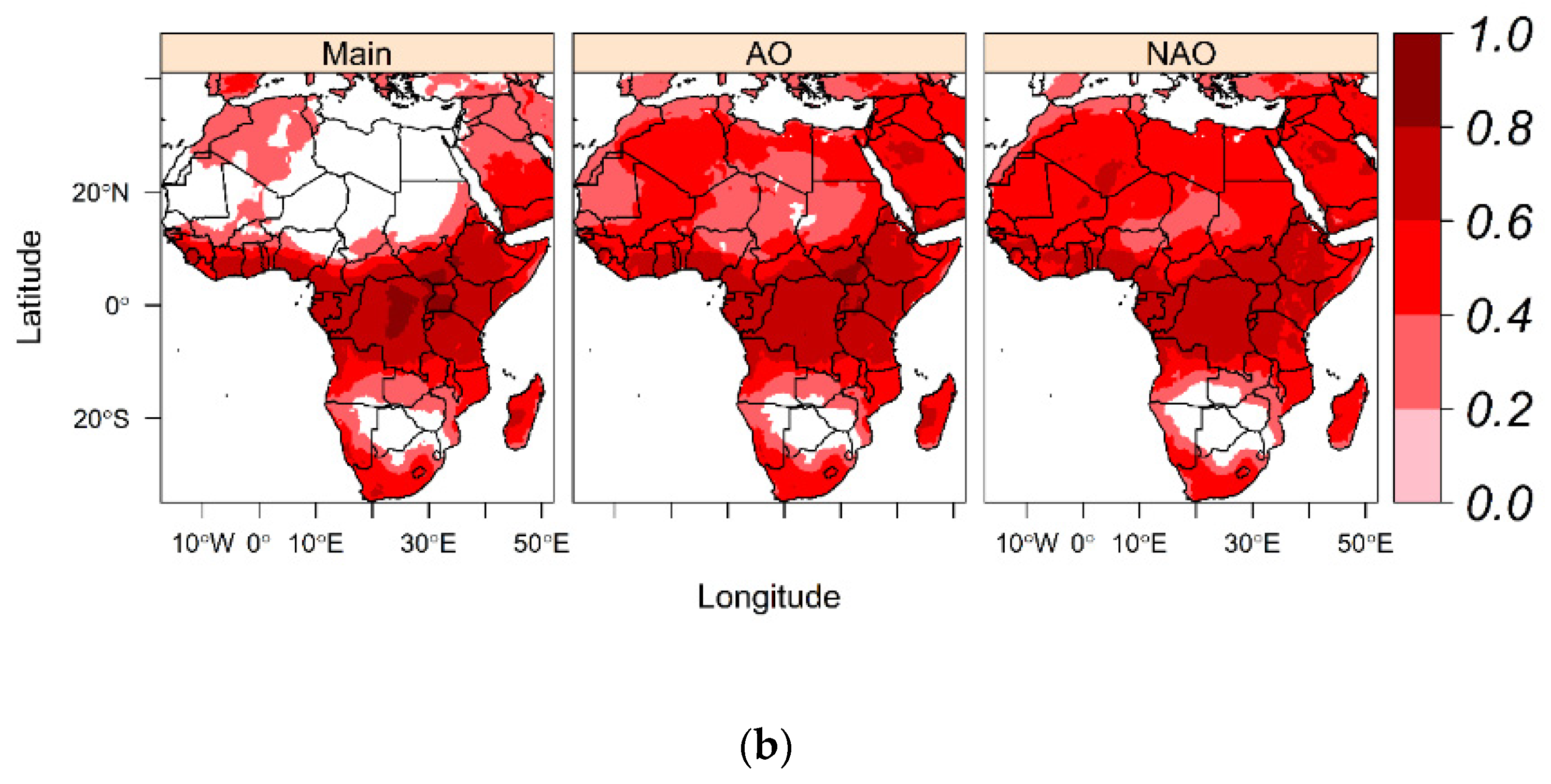
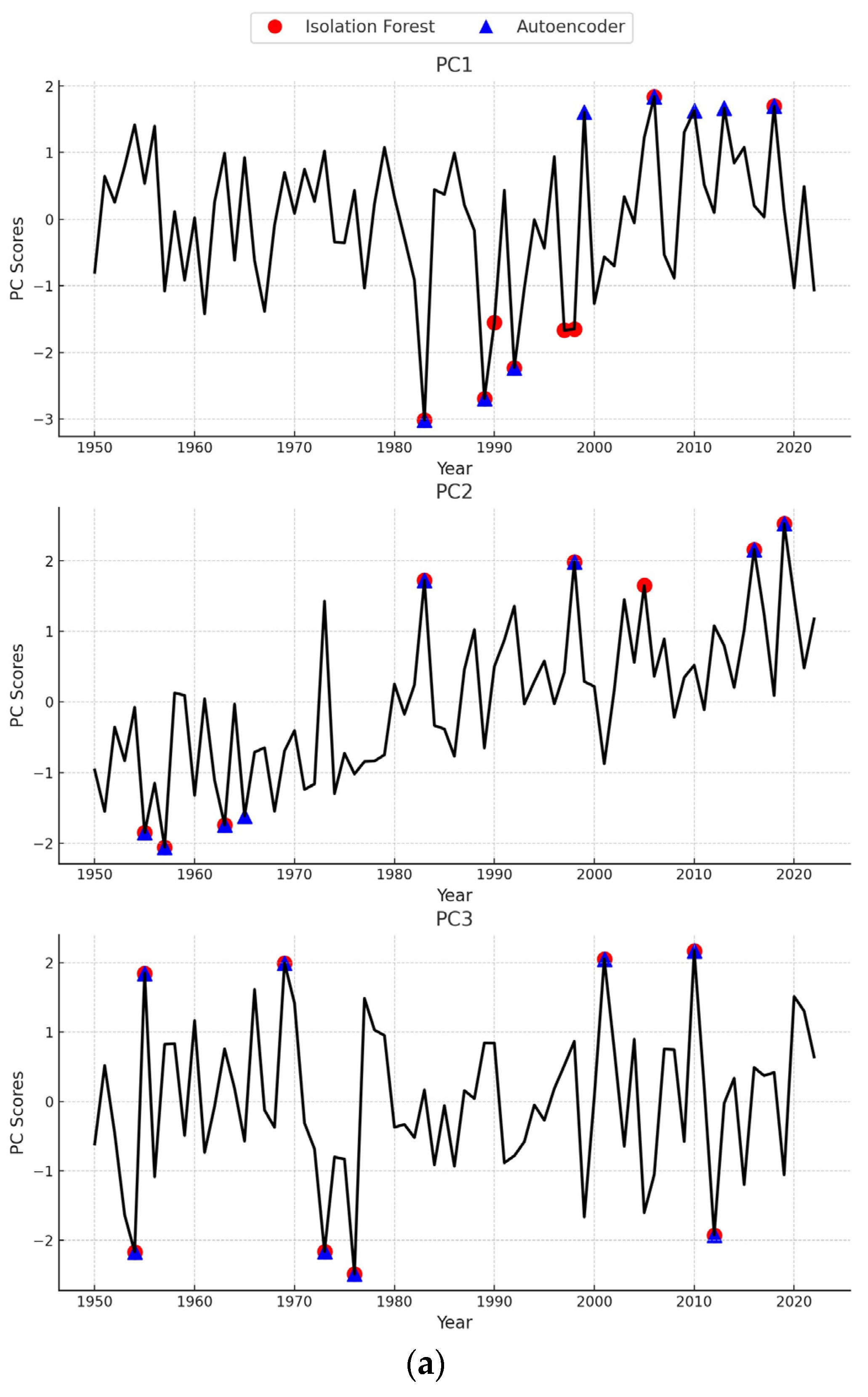
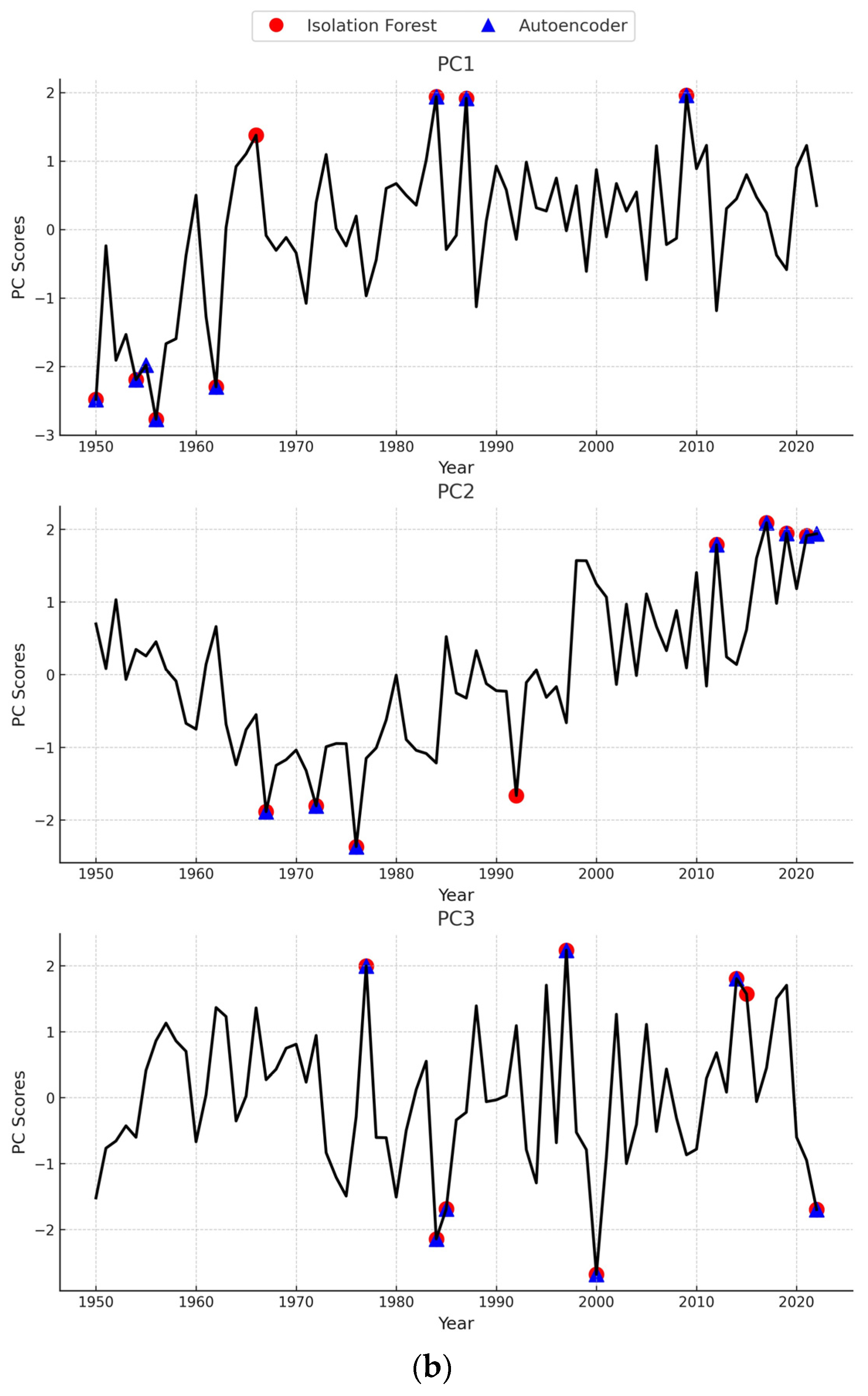

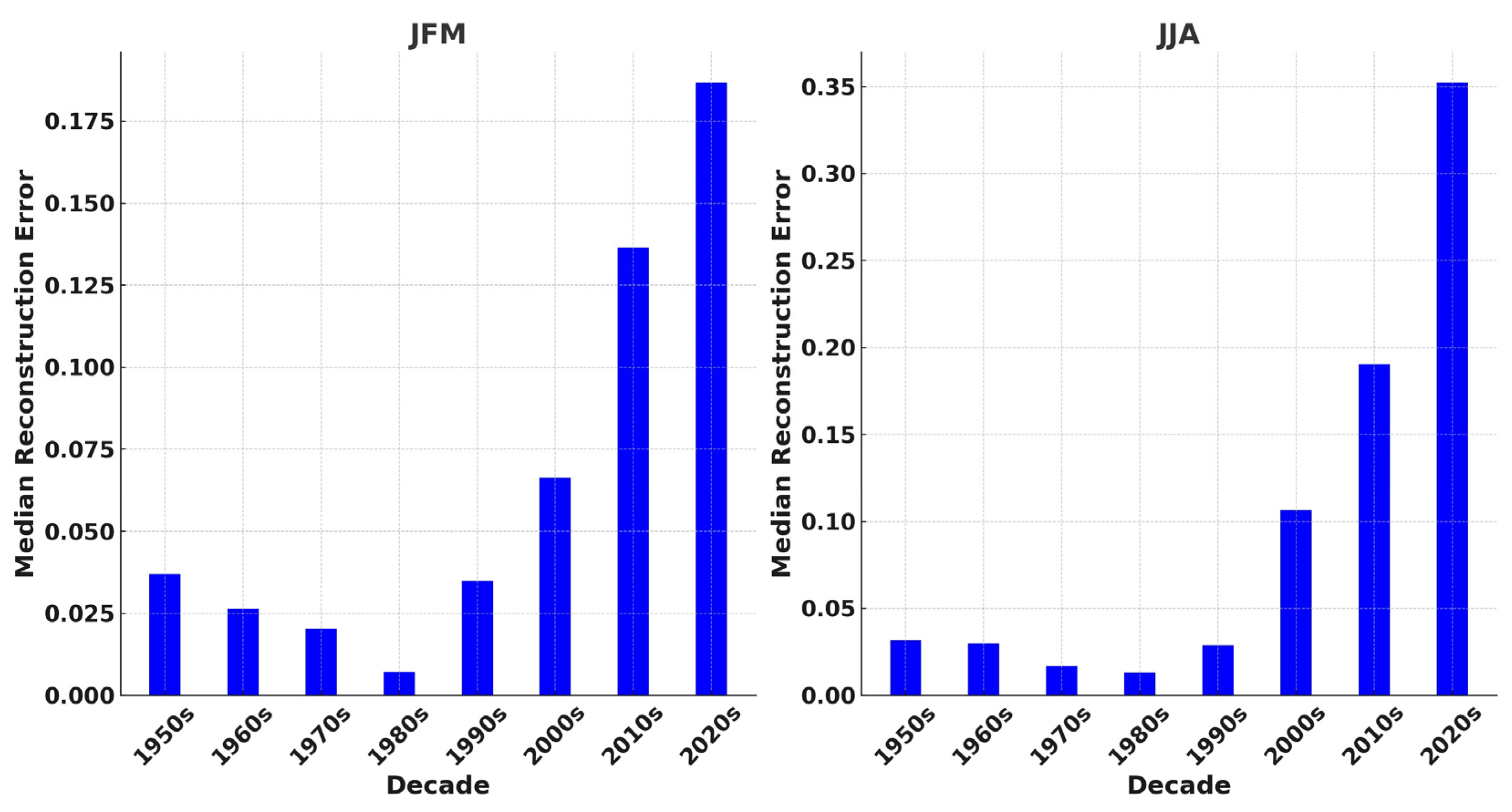
Disclaimer/Publisher’s Note: The statements, opinions and data contained in all publications are solely those of the individual author(s) and contributor(s) and not of MDPI and/or the editor(s). MDPI and/or the editor(s) disclaim responsibility for any injury to people or property resulting from any ideas, methods, instructions or products referred to in the content. |
© 2023 by the authors. Licensee MDPI, Basel, Switzerland. This article is an open access article distributed under the terms and conditions of the Creative Commons Attribution (CC BY) license (https://creativecommons.org/licenses/by/4.0/).
Share and Cite
Ibebuchi, C.C.; Abu, I.-O.; Nyamekye, C.; Agyapong, E.; Boamah, L. Utilizing Machine Learning to Examine the Spatiotemporal Changes in Africa’s Partial Atmospheric Layer Thickness. Sustainability 2024, 16, 256. https://doi.org/10.3390/su16010256
Ibebuchi CC, Abu I-O, Nyamekye C, Agyapong E, Boamah L. Utilizing Machine Learning to Examine the Spatiotemporal Changes in Africa’s Partial Atmospheric Layer Thickness. Sustainability. 2024; 16(1):256. https://doi.org/10.3390/su16010256
Chicago/Turabian StyleIbebuchi, Chibuike Chiedozie, Itohan-Osa Abu, Clement Nyamekye, Emmanuel Agyapong, and Linda Boamah. 2024. "Utilizing Machine Learning to Examine the Spatiotemporal Changes in Africa’s Partial Atmospheric Layer Thickness" Sustainability 16, no. 1: 256. https://doi.org/10.3390/su16010256
APA StyleIbebuchi, C. C., Abu, I.-O., Nyamekye, C., Agyapong, E., & Boamah, L. (2024). Utilizing Machine Learning to Examine the Spatiotemporal Changes in Africa’s Partial Atmospheric Layer Thickness. Sustainability, 16(1), 256. https://doi.org/10.3390/su16010256







